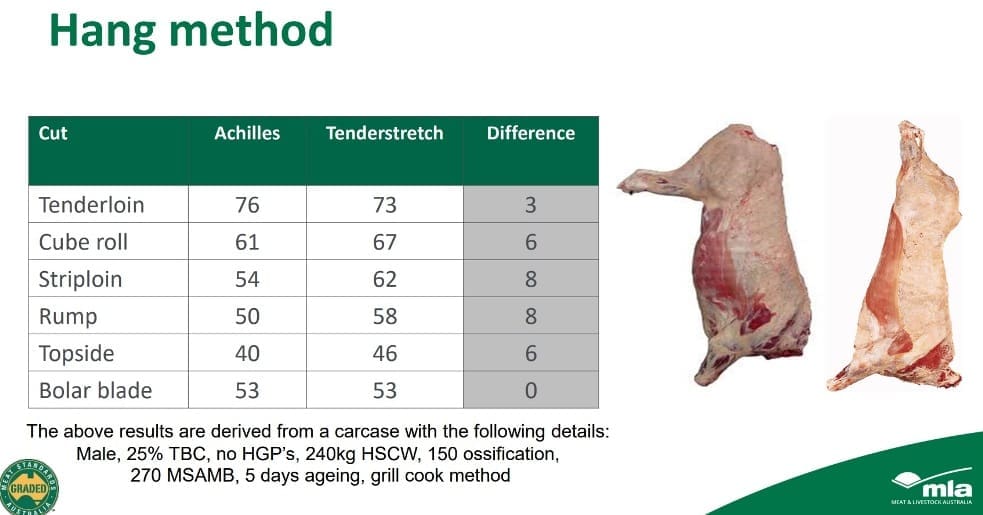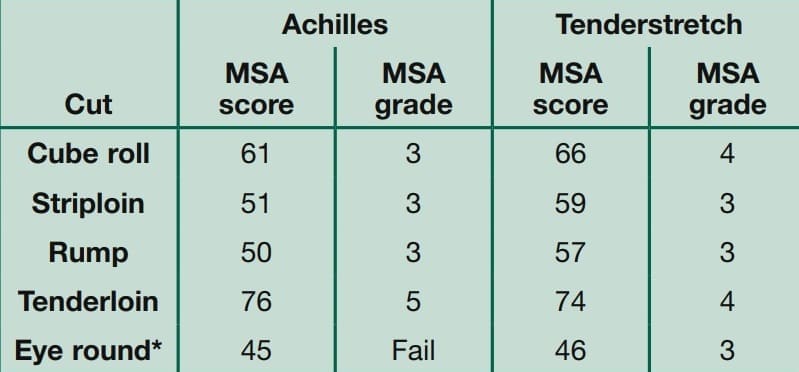THE industry-wide move from commodity to branded beef programs, and the financial incentive to optimise grading outcomes under Meat Standards Australia are driving renewed interest in the tenderstretch carcase hanging technique.
Tenderstretching is a method of hanging a carcase by the aitch-bone in the pelvis, or the ligament that runs down the back and over the tail of the animal, instead of the more conventional achilles hanging method.
The technique improves meat tenderness by preventing muscle shortening, and can produce considerably better outcomes than conventional achilles-hanging in MSA grading results (see detailed explanation below). Benefits vary from muscle to muscle, but greatest impact is seen on eating quality in the larger hindquarter cuts. Towards the front of the carcase, the effect is less significant.
As can be seen in the table published below, tenderstretching can have a significant impact on MSA scores for different cuts – as much as 8 points in the case of striploins and rumps, and six points in cube rolls and topsides in the example shown.

Tenderstrech-hung body left, and conventional achilles hung
The tenderstretch technique is certainly nothing new – it has been around at least since the 1970s – and its additional tenderisation effect in some muscles has been well documented since the early days of MSA meat science in the 1990s.
Adoption across industry has been modest, however. Currently 15 percent of all carcases presented for Meat Standards Australia grading are tenderstretched, with resistance being seen among non-user processors for a variety of reasons, described in more detail below.
Queensland processors dominate
The two biggest users of the technique in Australia are both in Queensland. That’s because tenderstretch provides a valuable tool in counteracting much of the indicus content (hump height) and HGP score penalties applied under MSA.
Australian Country Choice in Brisbane tenderstretches all 1200 yearling grainfed cattle it processes each day, mostly for supermarket customer Coles. The company has used the technique for at least 15 years.
Further north at Gympie, Nolan Meats tenderstretches about 550 carcases daily, as part of its MSA grainfed yearling processing model, using mostly crossbred cattle. It has employed tenderstretch in its operations for 23 years.
Queensland’s Churchill abattoir, which processed cattle for the Woolworths northern supply chain until it closed its doors unexpectedly in late 2017, also tenderstretched carcases, as does another (unnamed) larger northern processor who uses the technique specifically for certain brand program business, using beef with some bos indicus content.
In southern Australia, tenderstretch is much less common in processing, but its supporters include HW Greenham in Victoria and Tasmania (see details below) plus other quality-oriented meat supply chains like Gippsland Natural and Richard Gunner Fine Meats.
Overseas, tenderstretch is apparently almost unheard of in the US, but is widely used in the UK using the term, hip-suspension, where carcase weights tend to be lighter.
Why is tenderstretch not used more widely?
In gathering information for this report, while it was evident that adoption of tenderstretch has not exactly taken off like wildfire despite its meat quality impact, advocates for the system remain enthusiastically supportive, claiming that the benefits far outweigh any perceived downsides in using the process.
Although tenderstretch was proven to be effective in improving tenderness 25 years ago, it was not widely adopted due to the perceived inconvenience, extra cost and the lack of financial incentive for improved eating quality. However the strong benefit seen in MSA grading performance, and the equally strong trend towards branded beef programs in the last five years only adds to the incentive today.
Greenhams move to tenderstrech
Latest to adopt the tenderstretch technique in its operations is Victorian/Tasmanian processor HW Greenham.
Greenhams has been using tenderstretch for its Bass Strait brand program cattle out of Smithton in northwest Tasmania for the past three or four years, but when it purchased the Moe abattoir in Victoria last year, the decision was made to move to 100pc tenderstretch at the new Victorian plant, representing up to 350 cattle a day.
Greenhams is using tenderstretch to enhance eating quality outcomes on cows entering its new Vintage premium cow beef brand program being processed at both plants (click here to read more about the recently launched Vintage brand) , as well as yearling cattle being directed into the company’s Bass Strait brand.
“We’re seeing a considerable benefit in eating quality in striploins, cubes and rumps, particularly,” managing director Peter Greenham said.
“We’re finding we can get MSA four-star rib-eyes, and on some of the more highly marbled product, even four-star striploins applying tenderstretch to good quality cows entering the Vintage program,” he said.
While the move to tenderstretching at Moe required some adjustment to chillers and rails to accommodate carcases hung differently, fabrication staff had made the transition without any problems.
“Boners and slicers have adjusted quickly to tenderstretched carcases, because we did it from the start at Moe, since we re-opened the plant,” Mr Greenham said.
Point of difference in brand programs
In addition to the MSA eating quality advantages, Greenhams also sees the technique as an important point-of-difference from most other beef, and a key part of the brand story. This is proving particularly advantageous in export markets like the US, where tenderstretching is so rarely seen.
“We’re definitely looking at extending tenderstretch into other brand programs. It can make rumps eat more like eye fillet,” Mr Greenham said.
““The benefits to us significantly outweigh any drawbacks in using tenderstretch. It’s a no-brainer on our newer brand programs like Bass Strait and Vintage. On the beef cow program, because of their age, a lot more bodies would fall out of MSA, if we did not use tenderstretch.”
However Mr Greenham said it could take time to really extract the benefit out of adoption, while the extra costs associated with the technique tended to start ‘straight away.’
“It’s not for everybody, and I don’t think we are going to see a massive uptake of tenderstretching in Australia. Most plants are about optimising throughput volume, and you can’t do that with tenderstretch, unless you are well set up for it.”
Points of resistance
In discussions about the pros and cons with tenderstretching with processors, a number of issues tended to be frequently raised:
- The first is a reduced capacity in chillers, because tenderstretched carcases take up more space because of the way each side of beef hangs. Sometimes in chillers set up for Achilles hung bodies, rails must be repositioned to accommodate tenderstretched bodies. Air circulation in the chillers can also be impacted, unless configured properly, some told Beef Central.
- Boning speed can be compromised, because it is said to be harder to chase seams between primals with tenderstretched carcases. But countering that, plants that only bone tenderstretched carcases say they have no such problems, suggesting it is the ‘transition’ from boning the ‘old way’ (Achilles hung) to tenderstretched bodies that is the issue. The order of cuts extracted from the carcase can also change.
- Some primal muscles tend to change shape, because of the way the muscles rest when hung differently. Tenderstreched T-bones look a little different from T-bones from conventionally hung carcases, and rumps, butt fillets, topsides and outsides can tend to elongate. For appearance reasons alone, some butchers don’t like the shape of tenderstretched cuts, while others apparently prefer them.
- Yields on butt fillets, tenderloins and rumps can be compromised, some critics said, because it tends to be harder to get fillets out of the tenderstretched body. Others said that yield issue quickly disappeared when boners became better accustomed to handling tenderstretched beef.
All other attributes being equal, tenderstretch could improve a Bos Indicus influenced carcase’s eating quality to that of a non-tenderstreched British breed carcase, one of the principals of Nolan Meats in Queensland, Terry Nolan said.
“Non-supporters keep coming up with issues that they say keep them from considering tenderstretching, but we’ve found many of those issues can be overcome,” he said.
Tenderstretch explained
Tenderstretch is an alternative means of hanging the carcase during chilling. While carcases are traditionally hung by the heel (Achilles tendon), tenderstretch carcases may be hung either from the pelvic bone or through the TL ligament that runs down the back and over the tail of the animal.
How does tenderstretch work?
Tenderstretching can be done by a variety of methods. The most common is by positioning the hanging hook under the ligament that runs down the back of the animal or under the Aitch bone of the pelvis. When a carcase is tenderstretched, and suspended by the pelvis, the leg drops down at a 90-degree angle. As a result, a number of muscles are held in a stretched position so they cannot contract during rigor mortis. Tenderstretch is most effective in the hindquarter and has a varying effect on each cut.
Traditionally, the carcase is suspended by the Achilles tendon. In the Achilles hung carcase, shown in Diagram 1, the spine is curved and the rear leg muscles have less tension on them. As a result, when these muscles go through rigor mortis they can contract. When this occurs the muscle fibres overlap, resulting in slightly tougher meat.
The tenderstretch effect varies by muscle according to the position on the carcase and degree of stretching. This is shown in the following table.

The above data is taken from a standard MSA carcase with the following specifications: HSCW 240kg; male; 80mm hump; ossification 150; MSA marbling 270; meat colour 1C; rib fat 7mm; pH 5.55; loin temp 7.0˚C; ageing 5 days, cooking method grill and non HGP-treated.
Although the tenderstretch effect is slightly negative in the tenderloin, (which is stretched in an achilles hung carcase), it is strongly positive in most other hindquarter cuts and largely neutral in forequarter cuts other than the cube roll (ribeye). Tenderstretch is often a key factor in grading compliance for high tropical breed content cattle.

The technique’s benefits were demonstrated by early CSIRO work more than 25 years ago.
I think the last comment is pushing it a bit and I doubt anyone could taste the difference in tenderness between a tenderloin steak from a Achilles tendon hung side and the tenderness of a steak from the contralateral tenderloin from the other, Tenderstretched, side!